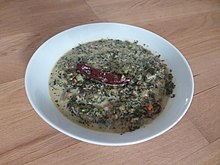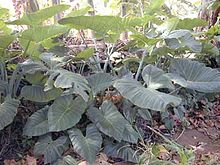Callaloo
Callaloo is a stew of Caribbean cuisine . The ingredients vary from country to country; common elements are merely the green color and a leafy vegetable as the main ingredient. In Trinidad and Tobago , it is considered a national dish.
origin
A dish similar to callaloo came to the Caribbean islands with slaves from West Africa . There the original ingredients were replaced by native plants. An exact date of the introduction of the dish is not possible, but Vidiadhar Surajprasad Naipaul proved the existence of callaloo in Trinidad as calalu for the late 18th century as a Sunday dinner.
Ingredients and preparation
Callaloo is also the name of the main ingredient, but it differs from region to region (albeit similar in taste). In Trinidad and Tobago the leaves of the taro plant , which contain calcium oxalate and must therefore be cooked thoroughly, are called "callaloo", whereas in Jamaica and Guyana the leaves of amaranth plants. In Puerto Rico , it is Xanthosoma roseum elsewhere are also young leaves of pokeweed , Solanum americanum or water spinach used. The Trinidadian callaloo (taro) is chopped by the local food industry and sold in supermarkets with a sealed flavor, often supplemented with dried spices to make a fix product.
Not only the main ingredient, but also the other ingredients vary depending on the region. In Jamaica, onions, tomatoes and habaneros are added, while in Trinidad and Tobago the ingredients include okra pods , coconut milk and fruits from Capsicum chinense .
The stew can be supplemented with an animal component; in addition to meat, crabs, mussels and lobsters are also used. As a rule, the soup (apart from any animal components) is pureed before serving.
Way of serving
Callaloo is usually served with side dishes. Where the soup or stew is vegetarian in its basic form, an animal component is added; in Trinidad, Barbados and Grenada this is mostly meat and rice, in Jamaica clipfish . In other regions, meat or fish is usually cooked with, and there side dishes are served, for example a porridge made from corn flour and okra called cou-cou in the Virgin Islands , and fufu made into balls from plantains and cassava called foo-foo in Guyana .
Metaphorical use of the name
The term "Callaloo" is also used metaphorically in Trinidad and, in the narrower sense, stands for a wild mix of ingredients, e.g. B. in food and in a broader sense for the prevailing, tolerably harmonious racial mix in Trinidad - Trinidad describes itself as the "Callaloo Nation".
Web links
Individual evidence
- ↑ Wisegeek.com: What is Callaloo? Retrieved February 19, 2017 .
- ↑ VS Naipaul: Farewell to Eldorado . List Verlag, Munich 2003, ISBN 3-548-60358-0 , pp. 217 .
- ↑ Callaloo on BV.I.com
- ↑ Linda Bladholm: Latin & Caribbean Grocery Stores Demystified . Renaissance Books, Los Angeles 2001, ISBN 1-58063-212-2 , pp. 189 .
- ↑ Callaloo on Chow.com
- ↑ Dave DeWitt & Mary Jane Wilson: Callaloo, Calypso & Carnival, p. 50. The Crossing Press 1993
- ^ Carnegie School of Home Economics: What's Cooking in Guyana . ?. Edition. Macmillan Caribbean, Oxford 2004, ISBN 978-1-4050-1313-0 , pp. 75 .
- ↑ Trinidad and Tobago dictionary
- ^ Aisha Khan, Callaloo Nation: Metaphors of Race and Religious Identity among South Asians in Trinidad, Duke University Press Books 2004, p. 4


